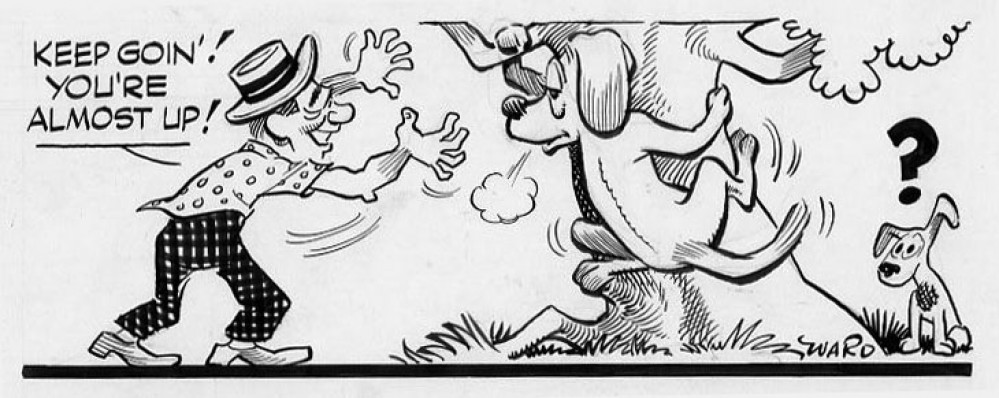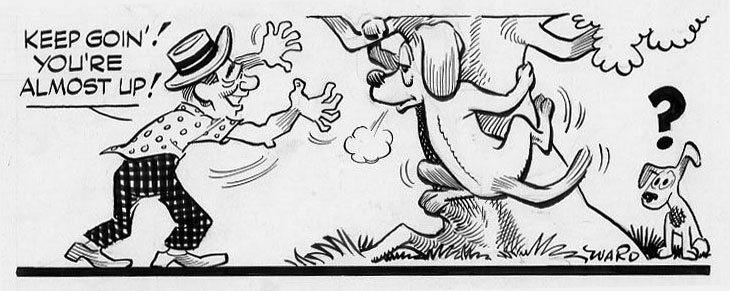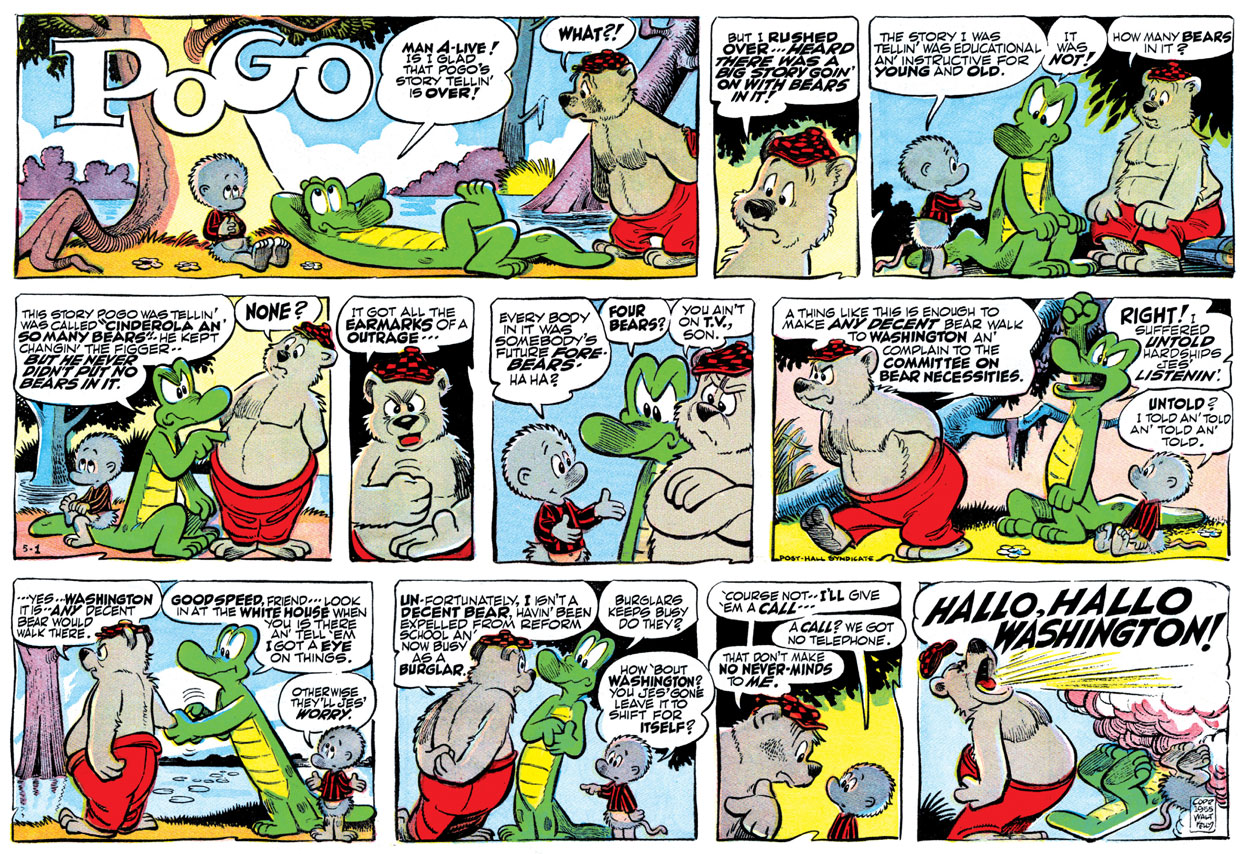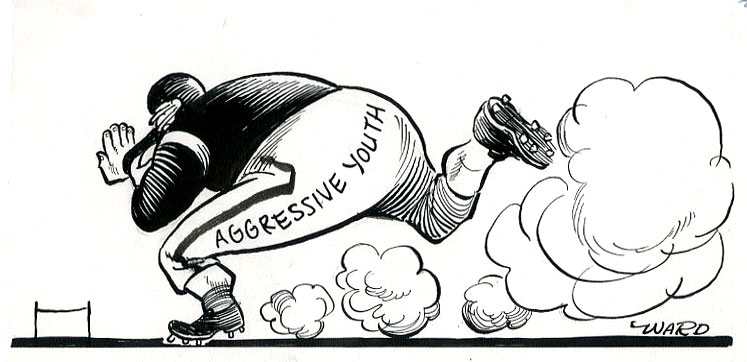Cartoon by George A. Ward (6 September 1966).
George A. Ward was an American cartoonist, working for magazines and newspapers like Life, Newsweek and the New York Daily News. Between 1948 and 1959, he was Walt Kelly's assistant on the 'Pogo' Sunday comic.
Early life
George Arthur Ward was born in 1921 in Scranton, Pennsylvania. He and his family were living in Philadelphia, when in 1940 Ward joined the Marines, serving overseas from 1942 to 1944. During his service, he was also active as a cartoonist. While stationed in Australia in 1943, he presented a bound book of his cartoons to the President's wife Eleanor Roosevelt, who was visiting his camp. Back in civilian life, Ward attended the Hussian School of Art in Philadelphia, Pennsylvania, where one of his fellow students was the future comic book artist Joe Maneely. Among his main influences during his career have been Roy Crane, Walt Kelly and John Liney.
Early career
By 1948, Ward was sharing a studio space with Maneely and another artist, Peggy Zangerle, in Philadelphia's Flo-Mar Building, at 3160 Kensington Avenue, Room 501. In that same year, he moved to New York City, where he got a job in the art department of a new daily newspaper, The New York Star. There, he made the acquaintance of Walt Kelly, who had an editorial cartoon in the paper, but was also working on his syndicated 'Pogo' strip. One day, Kelly walked into the office and asked who could help him with some lettering for his daily strip. Ward offered his services, and a fruitful collaboration took off.
Walt Kelly's assistant
In early 1949, the New York Star already disappeared from the market after only seven months. From then on, Ward began working for Walt Kelly on a more regular basis, dividing time between his own Greenwich Village apartment and Kelly's Connecticut home. At first, he assisted Kelly with the inking and lettering of the 'Pogo' comic books for Western Publishing. He also helped Kelly with his other artwork for Western, for instance his cover illustrations for the Disney comic books and the 'Peter Wheat' advertising strips for Bakers Associates, which appeared in giveaway comic books produced by Western Publishing. Between 1950 and 1952, Ward did other freelance work, for instance for the New York Compass, but he returned to Kelly in December 1952, and stayed with him until April 1959.
During the 1950s, Ward was mostly working on the Sunday episodes of the 'Pogo' newspaper strip, syndicated through the Hall Syndicate. It is unsure how much involvement he had in the actual artwork. In the 'Pogo Sunday Book', published by Simon and Schuster in 1956, Kelly prominently thanked him for his help, calling him "the best assistant a boy cartoonist ever had." The two men had also become good friends, and regularly went pub crawling in Manhattan's Costello's bar, a regular hangout for cartoonists and newspapermen. During the 1950s, many new characters were introduced in the 'Pogo' strip, many with their own characteristic lettering style. While Kelly's other assistant Henry Shikuma proved a master letterer, George Ward served as inker and occasional background artist on the 'Pogo' Sundays.
'Pogo' Sunday of 15 May 1955 featuring Barnstable the bear, presumably with prominent input from George Ward.
Unconfirmed rumors say that Kelly also let his assistant draw entire Sundays on his own. In a 2007 interview with Alter Ego magazine, the veteran comic artist Ramona Fradon, a friend of Ward's, said that all the episodes starring the simple-minded grizzly bear Barnstable were created by Ward. On the site of 'Pogo' fan Harry McCracken, a relative of George Ward commented that Ward's episodes can be identified by the way Pogo is drawn - Ward gave the character less hair - and by the very distinctive G in the Pogo title, that looks almost like a 6.
On the other hand, Ward himself has only described his inking work in interviews, and the Barnstable character continued to appear in the strips after he had left Kelly. Historians have also wondered that if Ward could perfectly mimic the 'Pogo' art style, why wasn't he asked to take over the comic after Walt Kelly's death in 1973?
Later career and death
After his tenure with Walt Kelly, George Ward did freelance and staff work for magazines and newspapers. His gag cartoons and other artwork have appeared in titles like Life, Newsweek, the New York Daily News and McCalls, and more sporadically in American Paper Converter, Leatherneck, the Philadelphia Evening Bulletin, Quantico Sentry and The Veteran's Journal. For many years, he worked in the art department of Newsweek magazine as a photo retoucher on the international edition. He also made advertising comics through Lennen and Newell Advertising.
George Ward died in February 2003 at the age of 82.
George Ward cartoon from August 1965.





